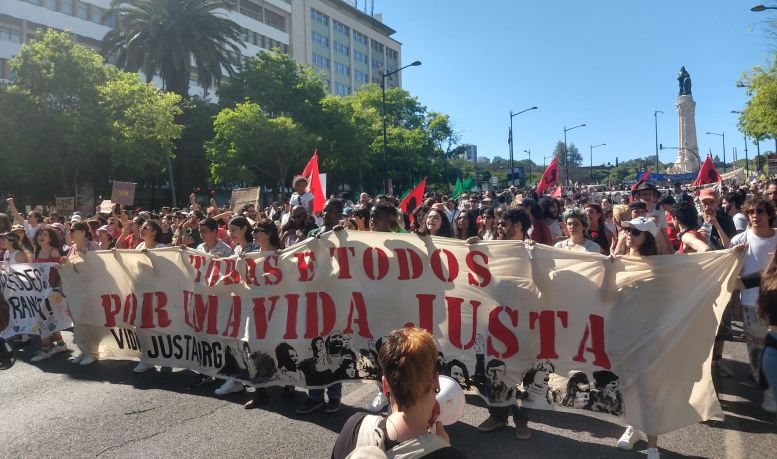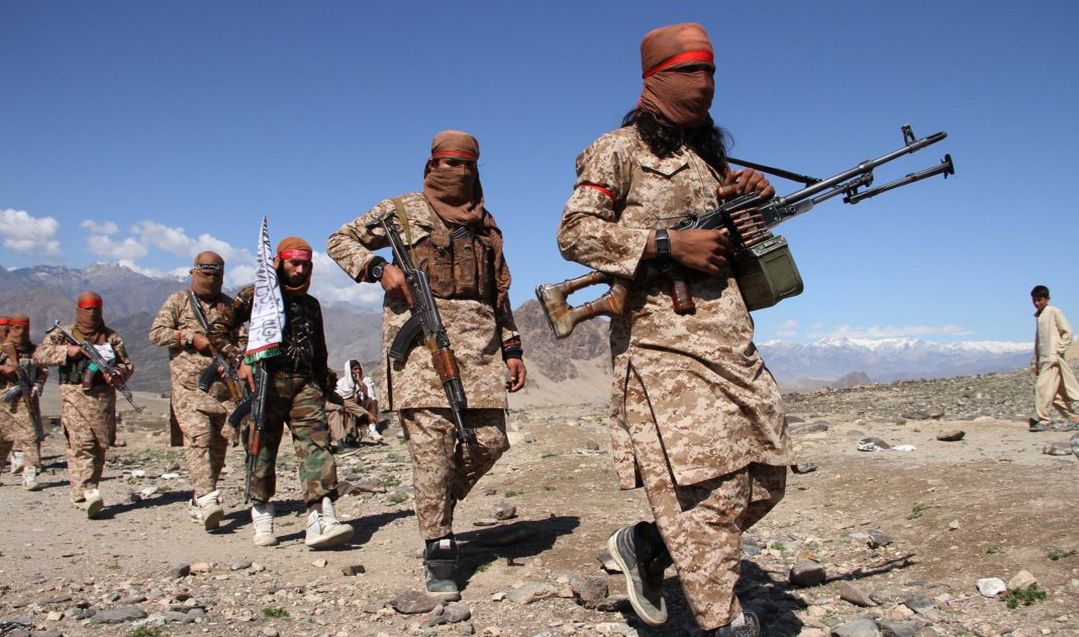Cristina is a member of ISA in Portugal.
Education workers rise up against their precarity, bringing 150,000 onto the streets of Lisbon. New unions and methods of struggle appear and stir up the still waters of the established unions.
The Decline of Public Education and the Challenges Workers Face Every Day
Over the last five decades, the rates of academic failure and school dropout have steeply declined in Portugal and today half of all students finish a higher education degree. Considering the insane rates of illiteracy before the 1974–75 revolution, this is commendable. Unfortunately, the percentage of GDP dedicated to Public Schools has also been declining in the last three decades and has been under 5% since 2016, a number not seen since 1995. Just last year, the state support for Special Education (education for children with special needs) was cut randomly, without even an effort to prioritize children in the worst conditions. With less funds and less support, it’s no wonder most schools complain of lack of resources to maintain increasingly cold and old buildings or get adequate educational materials and staff.
But resources aren’t the only thing lacking: public schools have been clearly understaffed lately. Twenty years ago, 6,000 young and motivated people concluded their Teaching degree, today the annual figure is 1,500. Thus, the aging of the teaching staff is inevitable. In public schools, half of them are over 50 years old. A study of the demand and supply of teachers in public schools up to 2030/2031 released by the Ministry of Education estimates that it would be necessary to hire 34,500 professionals, with Middle School (10–15 year-old students) and High School (15–18 year-old students) being the education levels most in need. The current rate is very far from satisfying those needs, which means more shortages of teaching personnel are expected in the next few years. To give an example, in 2021, only 3 people completed the Teaching degree in Physics and Chemistry, when the need was for 104 people. Faced with the chronic fact that thousands of students start the school year with lack of teachers and thus without classes, the PS (so-called Partido Socialista) government allowed undergraduates of Teaching Degrees and other graduated professionals to teach, which translates directly to lower quality public education.
But why are there so few people wanting to be teachers? Let’s see… maybe the prospect of a stagnated career and shameful precarity could be the answer. Newly starting teachers are confronted with a perspective of precarity, getting reassigned to different schools in different regions (sometimes 300 km away), on average for the first 16 years, never knowing if they’ll be unemployed next September or have a full schedule that will allow for a sufficient income. Only then may they enter the public school teacher career ladder. At the top of the career ladder, the average age is 60.7 years, with 38.6 years of service, while in the first step teachers have an average age of 45.4 years and 15.7 years of service. While in Elementary Schools (6–10 y.o. students) more than 85% of teachers are permanent staff, the same is not true for Middle and High schools where teachers with contracts of one year (or less) represent almost a quarter of staff. And once they finally become permanent at one school and get the stability they’ve dreamed of, teachers face strangling and stagnated quotas that block their advancement up the career ladder. Sadly, the same is true for all other education workers, as most public administration workers would need 120 years of service to get to the top of their career!
The lack of demand to become a teacher could also be due to the overcrowded classes and the extreme bureaucracy. When classes are finished for the day, teachers are forced to complete a never-ending stream of bureaucratic tasks on a daily basis — namely, filling out platforms and papers, identified by piled up and incomprehensible acronyms, to which are added piles of plans, lists, files, justifications, recovery plans and reports, among others. Not to mention the parents’ meetings, group meetings and department meetings. It is simply impossible for a teacher to work only 35 hours per week, as proved by an inquiry by FENPROF (a teachers’ union federation) into the working hours of Middle and High School teachers that shows they work, on average, more than 46 hours per week.
Middle and High School are the levels most affected by the decaying conditions of public education and coincidentally also the ones where academic failure and dropout rates tend to get higher. Given the successive failures of public schools, it is no surprise that some families with sufficient incomes prefer to pay for private schools. The attendance of private schools has been rising, with a fifth of all students attending one, even a quarter in High School. Differentiated education according to income and possessions means greater social inequalities.
It is urgent to strongly invest in public schools and in the careers of all school workers! The Teaching degree, and higher education as a whole, needs to be free of tuition fees and subsidized to attract new teachers while forming them at the highest quality standards. The state needs to provide good incentives and stable contracts to effectively hire teachers early in their careers, while reducing the number of students per class and improving education for all. To guarantee this, workers need to take control of their schools through democratic school commissions, together with the input from students, families and communities.
The Struggle of School Workers Erupts
The past few months has witnessed one of the greatest mobilizations of the last decade in Portugal, led by Education workers, including teachers, social workers, specialized technicians and other school staff.
It all started September 2022, when the Ministry of Education proposed alterations to the teachers’ recruitment model at a round of negotiations with the unions, making a case for municipal management and direct contracts by school directors. The proposal was poorly received, immediately contested in September and again in November, at a second round of negotiations. FENPROF (one of the biggest teachers’ union federations, member of the Communist Party-led trade union confederation CGTP) stated “We defend the primacy of the placement of teachers through the national recruitment competition and their professional graduation (calculated based on length of service)” and argued that the municipalization of schools would lead to an education at different speeds in the country, each municipality being responsible for how much to invest in each school or even for privatizing it, paving the way for more unequal education, increased precariousness and lower salaries and conditions for teachers and other education professionals.
On top of the miserable school and career conditions, the proposed change was the straw that broke the camel’s back. Anger about the proposed attack grew among education workers, along with demands to end quotas and allow career progression, to regularize working schedules to 35 hours/week, to reduce the distance between the workers’ home and the school they are placed in, for salary increases that match inflation and for earlier retirement. Based on this anger and demands, there was potential to mobilize workers onto the streets, to show the government that we’ve had enough of the exploitation and the disrespect with which education workers are treated. It would also have strengthened the Teachers’ Unions’ position at the negotiation table as the government was not giving in.
The Movement
On December 5, eight traditional teachers’ unions, led by FENPROF, finally called a demo for Saturday, March 4. Strike action was not on the table for these unions since the negotiations were still taking place, with the FENPROF leadership arguing that “it isn’t a suitable moment.” This attitude is in line with the usual “negotiator’s” posture that CGTP leadership takes on. This is a mistaken strategy, because what is achieved at the negotiation table is directly related to the balance of forces in the streets and the workplaces. Workers must rely on their own strength and organization to achieve victories, not just keep waiting for agreements with the capitalist state.
In the meantime, a layer of education workers was looking for a more combative way to fight for the interests of public education. A less known and independent (not part of the trade union confederations, neither CGTP nor UGT) education workers’ union “STOP” (Sindicato de Todos Os Profissionais da educação, union of all education workers) filled that space and took the initiative.
STOP arose in 2018, led by André Pestana, who was active in the education struggles since 2013 and critical of FENPROF’s leadership. A manifesto was written and signed by 200 teachers, for a new union, with “a different way of doing unionism and where the decision-making process would be completely democratic and non-partisan.”
Despite being a relatively small union (representing roughly 1,300 workers), STOP called for “indefinite strike actions” from December 9, a new form of struggle in the Portuguese trade union landscape that prolonged the strikes for an indefinite term. This model was supported by around 2,000 teachers in a poll carried out on an education blog in November. Education workers adhered to this strike in an unexpected massive movement, building democratic strike committees, closing schools and holding demos at the school gates for several days in a row, all over the country, specially in Porto and Lisbon Metropolitan Areas and in Algarve. Concretising solidarity through common struggle, STOP appealed to all school workers and not only teachers.
Pressured by this great mobilization of school workers and by the little openness of the ministry to new negotiation processes on other matters related to the teaching career, the eight traditional teachers’ unions also ended up calling for an 18-day strike, one day in each region (distrito) of the country, starting from January 16, as well as a demonstration in February. On December 17, a demo called by STOP brought 20,000 education workers to the streets. “Teachers fighting are also teaching” was one of the most heard slogans in the demo all the way to the Portuguese parliament. If 20,000 sounded like a lot at the time, it was nothing compared to the second demo called by STOP on January 14th, where 100,000 people gathered, bringing to the streets tens of thousands of non-unionized workers inspired by the previous demo. The government’s desperation was such that it resorted to the police to, through stop and search operations, try to prevent buses headed for the demonstration from reaching Lisbon, in a clear attempt at sabotaging the demo.
PS Government Uses Concessions Carrot and ‘Minimum Services’ Stick
Faced with the overwhelming strength of the school workers’ movement, in February the PS Prime Minister, António Costa, gave in and some concessions were won.
1. maintaining the professional graduation as the main criterion for the school placement competition, therefore retreating on the direct hiring proposal;
2. Holding the school placement competition for teachers (both permanent and hired) more frequently (annually), which will fill in the gaps immediately as older teachers retire;
3. Shortening the distance between the teacher’s homes and the school they can apply for;
4. Allowing some more career progressions by relaxing the quotas.
Even so, the government has not answered any of the longer term problems of public education nor conceded to the main demands of the movement.
The government also requested that the Court impose “minimum services” (forcing striking workers to work a set amount during strike action) on striking teachers from February 1, but only aimed this at STOP’s indefinite strike actions, performing what constitutes a direct attack to a union. In a statement, the Minister of Education justified this request with the “duration and unpredictability of the strikes enacted by STOP and the accumulated consequences for students, with regard to their protection, food and support in contexts of vulnerability”. “Parents at risk of losing their jobs” and “irreparable damage to students” was repeated by all commentators on radio, newspapers and television, in a clear attempt to turn parents against teachers. These minimum services in schools, supposedly aimed at ensuring meals for students and the care of children with special educational needs, in truth, shackled all school staff to mandatory schedules, preventing schools from closing again and denying the workers’ right to strike.
The government also questioned the “legality” of the strike funds, having asked for an opinion from the Attorney General’s Office and the General Inspectorate of Education and Science to investigate them. These are the same methods that were used to stop the nurses’ strike in 2018 and 2019, considered “illegal” for having collected funds through crowdfunding. Solidarity between workers of different sectors clearly makes the establishment tremble. This time too, the Attorney General’s Office classified the strike called by STOP as illegal.
The Need for Unity
In reply to this attack on the right to strike, a new demo was called by STOP for January 28, again reaching close to 100,000 demonstrators. FENPROF and the other traditional unions called for a demo on February 11, gathering around 150,000 people, which showed the willingness of their members to fight and their capacity for mobilization. STOP was not part of the organization of this protest, but called for the participation of its members. On February 25, STOP organized another very big demonstration for public education. And on March 4, FENPROF organized yet another demo, divided into two cities, gathering 40,000 people in Lisbon and another 40,000 in Porto.
Despite calls for convergence by STOP, the struggle kept moving forward with a platform of eight unions led by FENPROF on one side and STOP on the other, in competition. The split between the two unions became visible especially on the February 11 demo, when STOP’s leader André Pestana held a parallel rally on the sidelines of the demo, during Mário Nogueira’s speech, pointing the finger at the leader of FENPROF, accusing him of having prevented STOP from joining on stage to speak.
A United Front of all unions calling strikes on the same dates, with maximum democratic involvement and coordination of all education workers through the expansion of the STOP-promoted democratic strike committees could have a stronger impact than the current disunited approach.
Next Steps Forward
Despite the enduring will to fight by education workers, the movement is now more dispersed than at its height. STOP’s appeal to “indefinite strike actions” lasting since December, although motivating at first, has become tiring and dispersive, with workers taking strike action at different dates at different schools mostly in an uncoordinated manner.
As the government’s reaction starts to weigh on the struggle, new strategies and approaches are being considered by the trade unions. Starting on March 20, strikes called by FENPROF over overtime work, workload, the non-teaching component and the last class of the day began, even though there is no data to know how many teachers joined so far. New strikes by region (distrito) are also planned between April 17 and May 12, along with a national strike on June 6 and a strike on the final exams of the school year.
On March 18, a National Meeting of Union and Strike Commissions of STOP took place, taking the following decision: “In view of the fact that the government is managing to practically destroy our strike with the minimum services, we will maintain the national strike indefinitely only until the 16 of April (to allow for actions by colleagues who rely on our prior notices of strike). STOP will then test different strikes, for example strikes on a school-by-school basis on one morning and/or 1 day against poor conditions in schools, violence/indiscipline, school asbestos, special education, schools with shortage of Professionals of Education, etc and/or national/regional strikes of 1 or more days”. Among several proposals for action, the union encouraged the continuity of local forms of struggle, such as camps, vigils, marches in front of schools or on bridges. Another suggestion was putting up posters that embarrass Portugal in several languages to welcome tourists.
STOP calls for a 1-week strike, on April 24-28, with a demonstration on April 25 (anniversary of the Carnation Revolution of 1974), under the slogan “They always find money, except for working people!” (“Só não há dinheiro para quem trabalha!”), to unite all those that feel the degradation of public services and the loss of purchasing power. The call for a national education strike focused on one whole week is promising, but unity, mobilization and coordination are needed to have a real impact on the capitalist economy. Collaboration within schools and between schools would reinforce school closures and show the power and might of the working class.
School Struggles are an Inspiration. Let’s Build a Common Struggle Towards a General Strike
Indeed, the revolt of education workers against precarity is common to most of the working class, especially during the current cost of living and housing crises. The most effective way to beat the government and the capitalist class and recover public services is through a struggle of the whole working class. The struggles of education workers should serve as a pillar for a broader movement that aims at uniting the various struggles taking place for dignified salaries and living conditions by taking coordinated strike action by all trade unions and leading to the building of an effective general strike. The democratic strike committees and solidarity strike funds formed in the school struggles should be an inspiration to further promote the engagement of all workers in struggle, unionized and non-unionized alike, to democratically organize and coordinate the strikes and for the movement to gain strength and resist the natural wear out that a long struggle may cause.




